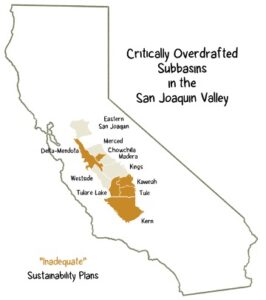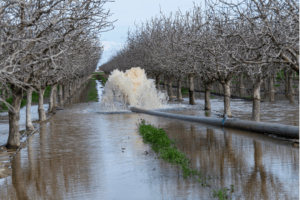In a land gripped by its history of drought, the Central Valley has planned poorly for its floods, threatening the lives and livelihoods of thousands.
A few days after the flooding in California’s Central Valley began in March, George Wurzel, the president and chief operating officer of JG Boswell Company, took the podium at an emergency Kings County board of supervisors meeting, already on the defensive. The Boswell Company was no stranger to floods – the founding Boswell had derived his fortune from claiming and draining much of the Tulare lake bottom that had once been the largest body of fresh water west of the Mississippi, and the lake was known for returning periodically despite the firm’s best efforts.
A remarkable but not unexpected combination of events had forced the issue: For the first time in precisely 40 years, the lake was pressing up against the too-low levee protecting the town of Corcoran, along with the largest concentration of incarcerated people in the state at two large prisons. The Boswell Company, with its large landholdings, was being accused of purposely driving flood water away from its own cropland and toward the town.
“There’s a lot of levees in the lake bottom for a reason. Most of the time when we have to take flood water it does not go to the lowest spot. We make a decision where to put it where it will have the least impact to the Boswell company and its employees,” said Wurzel. “We’re not maliciously trying to flood our neighbors. But you saw the numbers. Where are 1.2 million acre feet of water going to go?”
But the latest arrival of “the ghost lake” somehow took everyone by surprise. They had planned for it, in some way, but not well. They had bypassed environmental law, skirted regional emergency planning and over pumped the underlying aquifer so much that their levees were sinking in some places a foot each year.
A cascading series of short-sighted and unchecked decisions by government and private industry shaped this year’s Tulare lake, and made it the largest since its rivers were dammed: 178 square miles.
FORTUNES TIED TO FLOOD
The Tulare Lake once covered between 700 and 1000 square miles of low ground in California’s San Joaquin Valley, making it the largest body of freshwater west of the Mississippi. The first colonial settlers made their way into the Tulare lakebed clear-eyed and with few reservations. Federal programs that incentivized the claiming and drying of swamp land from coast to coast gave rise to a small number of savvy lake bed land barons. Tulare Lake was not so much drained, as it is often described, but displaced to reservoirs behind dams on the rivers that would feed the lake from the Sierra Nevada mountain range to the east. In those reservoirs, the lake’s waters – once a public resource – could be considered river flows subject to the development of water rights and ownership. The Boswell Company was one of those early settlers and water owners, and it enjoys those displaced lake rights still today.
The dams were meant to solve the lake problem, but California’s mercurial precipitation cycle proved too much. When the lake flooded in 1969 (130 square miles), the Army Corps of Engineers built an emergency levee to save the city of Corcoran at the water’s northeastern corner. When it flooded in 1983 (131 miles), the Army Corps again shored up the levee, on the condition that this would be the last time. The Corps then handed its operations over to a newly formed local flood district, funded by local property taxes. It was in that fog of flood, from 1984 through 1986, with unemployment reaching 35% and local school enrollment in Corcoran around 50%, that the community desperately courted the state for a prison project. “The community isn’t the same as it was 15 or 20 years ago,” rancher Jim Hansen said at the time. “Ag mechanization is not going to stop. The farm economy is as bad as I’ve ever seen it. Corcoran needs another anchor as far as industry.”
They presented three potential sites. The state chose the one in the lake bottom, and purchased the first piece of flood-prone land from the Boswell Company in 1985 for ten times its market value.
Pleased with Corcoran’s passion for the prison and bolstered by support from the behemoth Boswell, the Department of Corrections convinced the city and Kings County to request a total reprieve from state environmental law. With the passage of special legislation, the first Corcoran prison became the first project in California to enjoy no independent external environmental review. Warnings from legislators (“is it wise policy to suspend all independent review?”) and the Kings County Grand Jury (“would establish a dangerous precedent… a Pandora’s box”) were ignored. The project was fast-tracked, and the prison opened in 1988. When it didn’t entirely lift the fortunes of Corcoran’s ailing agricultural economy, the city requested another prison in 1993. Today the two prisons together house more incarcerated people than anywhere else in California, and comprise one of the largest concentrations of prisoners in the U.S.
“A NEW LAKEBED”
Boswell president Wurzel’s blunt comments at county meetings were exceedingly rare. The 100-year-old firm’s public relations strategy was summed up by the late J.G. Boswell himself – in paraphrase, “the whale that never surfaces is never caught.” No one spoke openly and on the record about company business. Boswell is less of a whale today than at the company’s peak, but it still owns nearly 130,000 acres of lake bottom clay in the San Joaquin Valley, seasonally planted almost entirely with processing tomatoes or cotton. More valuable yet, it owns the water and infrastructure on and around those acres. Its levees direct the flood and fortunes of everyone in the area. But for as flood-prone as the lake bottom may be, its fate has been defined recently by drought.
SUBSIDENCE ART
In 2017, an engineering firm produced a report on the area ground subsidence (its propensity to cave in), including projections for an entirely new floodplain. The flood in 2023 took on nearly that exact shape. “It’s a new lakebed,” said the Corcoran city manager Greg Gatzka.
FLOODPLAIN ART
That new lakebed put the city of Corcoran and the state’s two prisons in the direct path of the flood. But its management was largely left to Boswell and other private landowners, as it always had been. When county leaders proposed taking control by ordering Boswell to cut its own levees to relieve pressure off Corcoran and the prisons, the firm balked.
“I don’t believe that there’s law that supports where water should or should not go,” Boswell Company water engineer Dominic Sween said at the March 18 meeting.
“In 98 years, the county supervisors have never gotten involved in telling the Boswell company or Corcoran where to put flood water,” Wurzel said. “The county supervisors have never ever come down to poke a hole in a levee.”
A few days later they poked a hole. And the water kept coming.
THE FOG OF FLOOD
On an April visit to the fast-rising lake, Gov. Gavin Newsom couldn’t stifle a laugh as he spoke about the region’s unwillingness to plan ahead cooperatively for the known flooding risk. Kings, along with neighboring San Joaquin Valley counties of Tulare, Kern and Fresno had opted out of regional emergency flood planning, and it showed. There was further dysfunction, too. According to internal emails obtained with a public records request, following weeks of flooding, Kings County missed the deadline to request state and federal emergency assistance, sending Corcoran city leaders into a panic. They asked the state if they could divert pandemic funding to raise their levee. They were told no.
A crisis communications spokesperson for the office of emergency services told a reporter that Corcoran would be facing risks to its levee for up to two years. The Corcoran city manager, in a letter to the Department of Corrections pleading for money to shore up its levee, characterized “the flood fight” as “a desperate situation” and “a long enduring battle.”
While county leaders and Boswell argued over precedent and authority for managing floodwater on private land, the Department of Corrections made no public statements about its plans for the nearly 8,000 incarcerated people in its care at the two Corcoran prisons. The agency said it was working closely with the governor’s office of emergency services on planning, but internal emails show Corrections first sent a seven-page evacuation plan to the state office in late April, after the facilities had been surrounded by water for weeks. Corrections declined to provide any details from that plan, citing security risks.
When the governor announced a $17.2 million investment in fortifying the Corcoran levee, he also said, “The state and federal government cannot continue stepping in to raise this levee.” He cited the continued groundwater over pumping as the cause of the levee’s degradation. Almost simultaneously, the state Department of Water Resources rejected the lake bottom groundwater sustainability agency plans, in large part for their lack of planning to stop the subsidence. Without ongoing state intervention and support, Corcoran and the state’s own prisons will drown.
The governor’s office, emergency services and the state department of corrections declined to answer questions about what they had learned from the experience or how they might approach future floods differently. In August, the governor signed an executive order making more funding available for additional flood-protective measures. Another wet winter is predicted, while upwards of 80 square miles of Tulare lake remain inundated, and the Corcoran levee is still under siege.
And while Boswell president Wurzel may have lightly sparred with county leaders at those spring meetings, the company remains as powerful and influential as ever. The Boswell Company made a $60,000 donation directly to the local sheriff’s department, in thanks for the agency’s work during the flood. The county approved it in September.
Susie Cagle is examining the unintended consequences of California’s water policies during her fellowship year.


